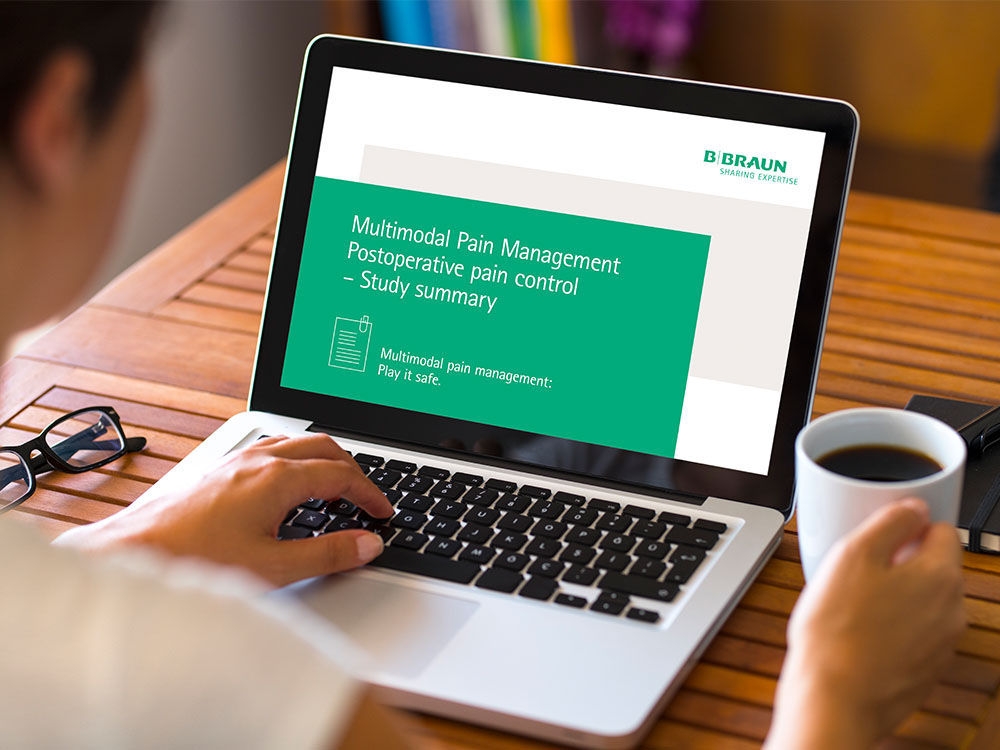No content results match your keyword.
Content
You have successfully logged out.
Not registered yet?
Multimodal Pain Management
Discover the benefits of multimodal analgesia for postoperative pain management.

“Managing postoperative acute pain is a challenge, as we need to treat acute pain as soon as possible to avoid chronic pain while minimizing opioid related risks.”
Multimodal pain therapy is a patient-centered approach, which combines therapies based on experiences as well as scientific research. Established key guidelines like PROSPECT Guideline (ESRA)3, ASA Guideline4, N1 Guideline (NICE UK)5 and S3 Guideline (Germany)6 recommend a multimodal approach to combine therapies for an effective pain relief and a reduction of side effects. Multimodal pain management can help to reduce the use of opioids and their associated risks.
Multimodal pain management can be used in chronic as well as in acute pain (e.g. after surgery). However, approaches differ.
In acute pain after surgery, the goal is to get to a tolerable pain level in order to reduce the risk of chronic pain and enable mobilization, while climbing down the pain ladder of medication as quickly as possible.
Multimodal pain management can include a variety of therapies, such as:
Pharmacological therapies: This may include non-opioid pain relievers, antidepressants, anticonvulsants, and topical pain relievers.
Non-pharmacological therapies: This may include physical therapy, occupational therapy, acupuncture, massage therapy, and cognitive-behavioral therapy.
The specific therapies used in multimodal pain management should be selected depending on the individual patient’s needs and condition. However, all multimodal pain management plans should be designed to provide effective pain relief while reducing the risk of side effects.
0%
of anesthesiologists use opioids as part of their post-operative IV pain medication.8
Often pain after surgery is not managed well.7 Multimodal pain management can help to provide a more effective pain relief while reducing side effects of medication. In case of a single approach treatment often very high doses or very strong analgesics are needed to manage pain effectively, which are often associated with more significant risks of side effects. Multimodal pain management can offer a number of benefits for both patients and hospitals.
However, multimodal pain management means more than just treating postoperative pain. The multimodal approach also has advantages during the operation. For a long time, perioperative pain treatment was dominated by opioids. Recently, awareness of the risk of developing addiction has grown.14, 15 In addition, these drugs have many undesirable side effects. Studies show that it is possible to effectively manage pain by combining different agents.16 These include opioids, but also NSAIDs and other analgesics. Multimodal pain treatment makes it possible to tailor therapy to the risk profile of your patients.
National and international guidelines can help to identify scientifically evaluated pain management approaches for multimodal pain management tailored to your patient in a surgery-specific way.
Even though there is no one-size-fits-all approach to manage pain, most guidelines have in common, that they try to provide a good pain relief and reduced opioid consumption after surgery by combining different measures such as non-opioid systemic treatment options, peripheral nerve blocks, pain catheters and local infiltration techniques.
Find out more about our solutions that can help you manage the pain of your patients in an efficient way.

PROSPECT Guideline (ESRA)
Better Postoperative Pain Management
link
ASA Guidelines
Management of Postoperative Pain: A Clinical Practice Guideline from the American Pain Society, the American Society of Regional Anesthesia and Pain Medicine, and the American Society of Anesthesiologists
link
N1 Guideline (NICE UK)
Perioperative care in adults – [N1] Evidence reviews for managing acute postoperative pain
link
S3 Guideline (Germany)
Treatment of acute perioperative and post-traumatic pain
link

The smaller the patient, the bigger the challenge – also in anesthesia. It is estimated that up to 82 % of all hospitalized pediatric patients suffer from moderate to severe pain.17 With serious effects: Studies show, that inadequate analgesia may delay recovery,18, 19 and cause morbidity or even mortality after surgical trauma.20 Vice versa effective pain management may improve the patient outcome detectably.18, 21, 22
The growing awareness of the risks of opioids is drawing increasing attention to multimodal pain therapy for children. It may decrease the use of opioids and the associated side effects while it can be more effective in pain control.23
To effectively relieve the pain of these vulnerable patients – without the need for off-label use – B. Braun offers various products: NSAIDs as well as other non-opioids specifically intended for pediatric use.
Discover our product portfolio> 0%
of drugs used in children have not been tested in or approved for children.24, 25
Enhancing safety is the most urgent demand we all share. Many studies give rise to scrutinize the all too frequent and long-term administration of opioids. All the more since there are effective and less risky alternatives like NSAIDs and other non-opioids, which feature safer molecules. Less opioids may mean less side effects, less risk of opioid addiction, and less complications with a potential medication change when it comes to home care.
Read more about how your patients benefit.
Download studies summary
It will be forwarded to a responsible contact person who will get in touch with you as soon as possible.
1. https://www.ncbi.nlm.nih.gov/books/NBK554435/
2. https://www.cfp.ca/content/56/6/514
4. https://esraeurope.org/prospect/
Chou, R., Gordon, D. B., de Leon-Casasola, O. A., Rosenberg, J. M., Bickler, S., Brennan, T., Carter, T., Cassidy, C. L., Chittenden, E. H., Degenhardt, E., Griffith,
S., Manworren, R., McCarberg, B., Montgomery, R., Murphy, J., Perkal, M. F., Suresh, S., Sluka, K., Strassels, S., Thirlby, R., Viscusi, E., Walco, G. A., Warner,
L., Weisman, S. J., and Wu, C. L. 2016. ‚Management of Postoperative Pain: A Clinical Practice Guideline From the American Pain Society, the American Society of Regional Anesthesia and Pain Medicine, and the American Society of Anesthesiologists’ Committee on Regional Anesthesia, Executive Committee, and Administrative Council’, J Pain, 17: 131-57.
7. Meißner, W, et al: The Quality of Postoperative Pain Therapy in German Hospital. Dtsch Arztebl Int 2017; 114: 161–7.
8. Survey among 100 anesthesiologists in Germany, Spain, Italy, UK and France, conducted in 2022.
9. https://www.scirp.org/html/1-1920609_98236.html
10. https://jamanetwork.com/journals/jamasurgery/article-abstract/2629299
11. Berend ME, Berend KR, Lombardi AV., Jr Advances in pain management game changers in knee arthroplasty. Bone Joint J. 2014;96(Suppl):7–9.
12. Maher DP, Woo P, Wong W, Zhang X, Yumul R, Louy C. Perioperative factors associated with Hospital Consumer Assessment of Healthcare Providers and Systems responses of total hip arthroplasty patients. J Clin Anesth. 2016;34:232–238.
13. https://www.painphysicianjournal.com/current/pdf article=NjUwNA%3D%3D&journal=122
14. Volkow ND, Jones EB, Einstein EB, Wargo EM. Prevention and Treatment of Opioid Misuse and Addiction: A Review. JAMA Psychiatry. 2019 Feb 1;76(2):208-216. doi: 10.1001/jamapsychiatry.2018.3126. PMID: 30516809.
15. Dydyk AM, Jain NK, Gupta M. Opioid Use Disorder. 2024 Jan 17. In: StatPearls [Internet]. Treasure Island (FL): StatPearls Publishing; 2024 Jan–.PMID: 31985959.
16. Wick EC, Grant MC, Wu CL. Postoperative Multimodal Analgesia Pain Management With Nonopioid Analgesics and Techniques: A Review. JAMA Surg. 2017;152(7): 691–97.
17. O’Donnell FT, Rosen KR. Pediatric Pain Management: A review. Mo Med. 2014 May-Jun; 111(3): 231–237.
18. D’Amours RH et al., JOSPT 1996; 24(4): 227 - 36
19. Pavlin DJ et al., Anesth Analg 2002;95: 627 - 35
20. Verghese ST & Hannallah RS. Acute pain management in children. J Pain Res. 2010; 3: 105–123.
21. Khelet H, Br J Anaesth 1997;78: 606-17
22. Jayr C, In Les Aspects Economiques de l’Anesthésie. JEPU 2000: 131-8
23. Graff V, Grosh T. Multimodal Analgesia and Alternatives to Opioids for Postoperative Analgesia. The official journal of the anesthesia patient safety foundation 2018 Oct; 33(2): 33–68.
24. Boston Children’s Hospital. Division of General Pediatrics. What to consider when considering “off-label” drug prescriptions for children. https://www.childrenshospital.org/centers-and-services/departments/general-pediatrics/clinician-resources/off-label-drug-prescriptions (last access 6.5.21).
25. European Commission. Better Medicines for Children From Concept to Reality. Progress Report on the Pediatric Regulation (EC) No. 1901/2003. 2013.
Your feedback matters! Participate in our customer survey to help us enhance our website, products and services. Thank you for your support!